Coupled Impacts of Soil Acidification and Climate Change on Future Crop Suitability in Ethiopia
Abstract
1. Introduction
2. Materials and Methods
2.1. Study Area
2.2. Climate and Soil Data
2.3. Crop Suitability Modeling
2.4. Model Calibration and Validation
2.5. Assessing Impacts of Soil Acidification on Crop Suitability under Climate Change
3. Results
3.1. Climate, Soil pH and Crop Suitability in Ethiopia under Current Climate
3.2. Projected Climate and Crop Suitability in Ethiopia
3.3. Effect of Different Levels of Soil Acidification on Changes in Crop Suitability under Climate Change
4. Discussion
5. Conclusions
Author Contributions
Funding
Institutional Review Board Statement
Informed Consent Statement
Data Availability Statement
Acknowledgments
Conflicts of Interest
Correction Statement
References
- Field, C.B.; Van Aalst, M.; Adger, W.N.; Arent, D.; Barnett, J.; Betts, R.; Bilir, E.; Birkmann, J.; Carmin, J.; Chadee, D.; et al. Part A: Global and Sectoral Aspects: Volume 1, Global and Sectoral Aspects: Working Group II Contribution to the Fifth Assessment Report of the Intergovernmental Panel on Climate Change; Cambridge University Press: Cambridge, UK, 2014; pp. 1–1101. [Google Scholar]
- Chemura, A.; Schauberger, B.; Gornott, C. Impacts of Climate Change on Agro-Climatic Suitability of Major Food Crops in Ghana. PLoS ONE 2020, 15, e0229881. [Google Scholar] [CrossRef]
- Srinivasan, R.; Giannikas, V.; Kumar, M.; Guyot, R.; McFarlane, D. Modelling Food Sourcing Decisions under Climate Change: A Data-Driven Approach. Comput. Ind. Eng. 2019, 128, 911–919. [Google Scholar] [CrossRef]
- Asseng, S.; Ewert, F.; Martre, P.; Rötter, R.P.; Lobell, D.B.; Cammarano, D.; Kimball, B.A.; Ottman, M.J.; Wall, G.W.; White, J.W.; et al. Rising Temperatures Reduce Global Wheat Production. Nat. Clim. Change 2015, 5, 143–147. [Google Scholar] [CrossRef]
- Rosenzweig, C.; Elliott, J.; Deryng, D.; Ruane, A.C.; Müller, C.; Arneth, A.; Boote, K.J.; Folberth, C.; Glotter, M.; Khabarov, N.; et al. Assessing Agricultural Risks of Climate Change in the 21st Century in a Global Gridded Crop Model Intercomparison. Proc. Natl. Acad. Sci. USA 2014, 111, 3268–3273. [Google Scholar] [CrossRef]
- Asseng, S.; Foster, I.; Turner, N.C. The Impact of Temperature Variability on Wheat Yields. Glob. Change Biol. 2011, 17, 997–1012. [Google Scholar] [CrossRef]
- Rowhani, P.; Lobell, D.B.; Linderman, M.; Ramankutty, N. Climate Variability and Crop Production in Tanzania. Agric. For. Meteorol. 2011, 151, 449–460. [Google Scholar] [CrossRef]
- Elias, E. Characteristics of Nitisol Profiles as Affected by Land Use Type and Slope Class in Some Ethiopian Highlands. Environ. Syst. Res. 2017, 6, 20. [Google Scholar] [CrossRef]
- Chimdi, A.; Gebrekidan, H.; Kibret, K.; Tadesse, A. Effects of Liming on Acidity-Related Chemical Properties of Soils of Different Land Use Systems in Western Oromia, Ethiopia. World J. Agric. Sci. 2012, 8, 560–567. [Google Scholar]
- Alemu, E.; Selassie, Y.G.; Yitaferu, B. Effect of Lime on Selected Soil Chemical Properties, Maize (Zea mays L.) Yield and Determination of Rate and Method of Its Application in Northwestern Ethiopia. Heliyon 2022, 8, e08657. [Google Scholar] [CrossRef]
- Abate, T.; Shiferaw, B.; Menkir, A.; Wegary, D.; Kebede, Y.; Tesfaye, K.; Kassie, M.; Bogale, G.; Tadesse, B.; Keno, T. Factors That Transformed Maize Productivity in Ethiopia. Food Secur. 2015, 7, 965–981. [Google Scholar] [CrossRef]
- Fageria, N.K.; dos Santos, A.B.; Moraes, M.F. Influence of Urea and Ammonium Sulfate on Soil Acidity Indices in Lowland Rice Production. Commun. Soil Sci. Plant Anal. 2010, 41, 1565–1575. [Google Scholar] [CrossRef]
- Stumpe, J.M.; Vlek, P.L.G. Acidification Induced by Different Nitrogen Sources in Columns of Selected Tropical Soils. Soil Sci. Soc. Am. J. 1991, 55, 145–151. [Google Scholar] [CrossRef]
- Bolan, N.S.; Curtin, D.; Adriano, D.C. Acidity; Hillel, D., Ed.; Elsevier: Oxford, UK, 2005; pp. 11–17. [Google Scholar]
- Blake, L. Acid Rain and Soil Acidification; Hillel, D., Ed.; Elsevier: Oxford, UK, 2005; pp. 1–11. [Google Scholar]
- Pierre, W.H.; Banwart, W.L. Excess-Base and Excess-Base/Nitrogen Ratio of Various Crop Species and Parts of Plants. Agron. J. 1973, 65, 91–96. [Google Scholar] [CrossRef]
- Reeves, J.L.; Liebig, M.A. Depth Matters: Soil pH and Dilution Effects in the Northern Great Plains. Soil Sci. Soc. Am. J. 2016, 80, 1424–1427. [Google Scholar] [CrossRef]
- Goulding, K.W.T. Soil Acidification and the Importance of Liming Agricultural Soils with Particular Reference to the United Kingdom. Soil Use Manag. 2016, 32, 390–399. [Google Scholar] [CrossRef]
- Desta, G.; Kassawmar, T.; Tadesse, M.; Zeleke, G. Extent and Distribution of Surface Soil Acidity in the Rainfed Areas of Ethiopia. Land Degrad. Dev. 2021, 32, 5348–5359. [Google Scholar] [CrossRef]
- Trunhe, A.M.; Yli-Halla, M.J. Effects of Applications of Lime, Wood Ash, Manure and Mineral p Fertilizer on the Inorganic p Fractions and Other Selected Soil Chemical Properties on Acid Soil of Farta District, Northwestern Highland of Ethiopia. Afr. J. Agric. Res. 2016, 11, 87–99. [Google Scholar]
- Abate, E.; Hussein, S.; Laing, M.; Mengistu, F. Soil Acidity under Multiple Land-Uses: Assessment of Perceived Causes and Indicators, and Nutrient Dynamics in Small-Holders’ Mixed-Farming System of Northwest Ethiopia. Acta Agric. Scand. Sect. B Soil Plant Sci. 2017, 67, 134–147. [Google Scholar] [CrossRef]
- The, C.; Calba, H.; Zonkeng, C.; Ngonkeu, E.L.M.; Adetimirin, V.O.; Mafouasson, H.A.; Meka, S.S.; Horst, W.J. Responses of Maize Grain Yield to Changes in Acid Soil Characteristics after Soil Amendments. Plant Soil 2006, 284, 45–57. [Google Scholar] [CrossRef]
- Ramankutty, N.; Foley, J.A.; Norman, J.; McSweeney, K. The Global Distribution of Cultivable Lands: Current Patterns and Sensitivity to Possible Climate Change. Glob. Ecol. Biogeogr. 2002, 11, 377–392. [Google Scholar] [CrossRef]
- Sainju, U.M.; Ghimire, R.; Pradhan, G.P. Nitrogen Fertilization i: Impact on Crop, Soil, and Environment. In Nitrogen Fixation; IntechOpen: London, UK, 2019; pp. 69–90. [Google Scholar]
- Sadeghpour, A.; Ketterings, Q.M.; Godwin, G.S.; Czymmek, K.J. Under- or Over-Application of Nitrogen Impact Corn Yield, Quality, Soil, and Environment. Agron. J. 2017, 109, 343–353. [Google Scholar] [CrossRef]
- Zeleke, T.T.; Giorgi, F.; Diro, G.T.; Zaitchik, B.F. Trend and Periodicity of Drought over Ethiopia. Int. J. Climatol. 2017, 37, 4733–4748. [Google Scholar] [CrossRef]
- Araya, A.; Stroosnijder, L. Assessing Drought Risk and Irrigation Need in Northern Ethiopia. Agric. For. Meteorol. 2011, 151, 425–436. [Google Scholar] [CrossRef]
- Segele, Z.T.; Lamb, P.J. Characterization and Variability of Kiremt Rainy Season over Ethiopia. Meteorol. Atmos. Phys. 2005, 89, 153–180. [Google Scholar] [CrossRef]
- Evangelista, P.; Young, N.; Burnett, J. How Will Climate Change Spatially Affect Agriculture Production in Ethiopia? Case Studies of Important Cereal Crops. Clim. Change 2013, 119, 855–873. [Google Scholar] [CrossRef]
- Yohannes, H.; Soromessa, T. Land Suitability Assessment for Major Crops by Using GIS-Based Multi-Criteria Approach in Andit Tid Watershed, Ethiopia. Cogent Food Agric. 2018, 4, 1470481. [Google Scholar] [CrossRef]
- Girmay, G.; Sebnie, W.; Reda, Y. Land Capability Classification and Suitability Assessment for Selected Crops in Gateno Watershed, Ethiopia. Cogent Food Agric. 2018, 4, 1532863. [Google Scholar] [CrossRef]
- Selassie, Y.G.; Ayalew, G.; Elias, E.; Getahun, M. Soil Characterization and Land Suitability Evaluation to Cereal Crops in Yigossa Watershed, Northwestern Ethiopia. J. Agric. Sci. 2014, 6, 109. [Google Scholar] [CrossRef]
- Gurmessa, B. Soil Acidity Challenges and the Significance of Liming and Organic Amendments in Tropical Agricultural Lands with Reference to Ethiopia. Environ. Dev. Sustain. 2021, 23, 77–99. [Google Scholar] [CrossRef]
- Takala, B. Soil Acidity and Its Management Options in Western Ethiopia: Review. Environ. Earth Sci. 2019, 9, 27–35. [Google Scholar] [CrossRef]
- Golla, A.S. Soil Acidity and Its Management Options in Ethiopia: A Review. Int. J. Sci. Res. Manag. 2019, 7, 2321–3418. [Google Scholar] [CrossRef]
- Jimma, T.B.; Demissie, T.; Diro, G.T.; Ture, K.; Terefe, T.; Solomon, D. Spatiotemporal Variability of Soil Moisture over Ethiopia and Its Teleconnections with Remote and Local Drivers. Theor. Appl. Climatol. 2023, 151, 1911–1929. [Google Scholar] [CrossRef]
- Zeleke, T.; Giorgi, F.; Tsidu, G.M.; Diro, G.T. Spatial and Temporal Variability of Summer Rainfall over Ethiopia from Observations and a Regional Climate Model Experiment. Theor. Appl. Climatol. 2013, 111, 665–681. [Google Scholar] [CrossRef]
- Diro, G.T.; Grimes, D.I.F.; Black, E.; O’Neill, A.; Pardo-Iguzquiza, E. Evaluation of Reanalysis Rainfall Estimates over Ethiopia. Int. J. Climatol. A J. R. Meteorol. Soc. 2009, 29, 67–78. [Google Scholar] [CrossRef]
- Gebrechorkos, S.H.; Taye, M.T.; Birhanu, B.; Solomon, D.; Demissie, T. Future Changes in Climate and Hydroclimate Extremes in East Africa. Earth’s Future 2023, 11, e2022EF003011. [Google Scholar] [CrossRef]
- Yigezu Wendimu, G. The Challenges and Prospects of Ethiopian Agriculture. Cogent Food Agric. 2021, 7, 1923619. [Google Scholar] [CrossRef]
- Fick, S.E.; Hijmans, R.J. WorldClim 2: New 1-km Spatial Resolution Climate Surfaces for Global Land Areas. Int. J. Climatol. 2017, 37, 4302–4315. [Google Scholar] [CrossRef]
- Brief, C. Climate Modelling Explainer: How Shared Socio-Economic Pathways Explore Future Climate Change. 2018. Available online: https://www.carbonbrief.org/explainer-how-shared-socioeconomic-pathways-explore-future-climate-change/ (accessed on 2 January 2024).
- John, J.G.; Blanton, C.; McHugh, C.; Radhakrishnan, A.; Rand, K.; Vahlenkamp, H.; Wilson, C.; Zadeh, N.T.; Dunne, J.P.; Dussin, R.; et al. NOAA-GFDL GFDL-ESM4 Model Output Prepared for CMIP6 ScenarioMIP Ssp370; WDCC: Hamburg, Germany, 2018. [Google Scholar] [CrossRef]
- Schupfner, M.; Wieners, K.-H.; Wachsmann, F.; Steger, C.; Bittner, M.; Jungclaus, J.; Früh, B.; Pankatz, K.; Giorgetta, M.; Reick, C.; et al. DKRZ MPI-ESM1.2-HR Model Output Prepared for CMIP6 ScenarioMIP Ssp370; WDCC: Hamburg, Germany, 2019. [Google Scholar] [CrossRef]
- Yukimoto, S.; Koshiro, T.; Kawai, H.; Oshima, N.; Yoshida, K.; Urakawa, S.; Tsujino, H.; Deushi, M.; Tanaka, T.; Hosaka, M.; et al. MRI MRI-ESM2.0 Model Output Prepared for CMIP6 ScenarioMIP Ssp370; WDCC: Hamburg, Germany, 2019. [Google Scholar] [CrossRef]
- Good, P.; Sellar, A.; Tang, Y.; Rumbold, S.; Ellis, R.; Kelley, D.; Kuhlbrodt, T. MOHC UKESM1.0-LL Model Output Prepared for CMIP6 ScenarioMIP Ssp370; WDCC: Hamburg, Germany, 2019. [Google Scholar] [CrossRef]
- Volodin, E.; Mortikov, E.; Gritsun, A.; Lykossov, V.; Galin, V.; Diansky, N.; Gusev, A.; Kostrykin, S.; Iakovlev, N.; Shestakova, A.; et al. INM INM-CM5-0 Model Output Prepared for CMIP6 ScenarioMIP Ssp370; WDCC: Hamburg, Germany, 2019. [Google Scholar] [CrossRef]
- Lovato, T.; Peano, D.; Butenschön, M. CMCC CMCC-ESM2 Model Output Prepared for CMIP6 ScenarioMIP Ssp370; WDCC: Hamburg, Germany, 2021. [Google Scholar] [CrossRef]
- Boucher, O.; Denvil, S.; Levavasseur, G.; Cozic, A.; Caubel, A.; Foujols, M.-A.; Meurdesoif, Y.; Cadule, P.; Devilliers, M.; Dupont, E.; et al. IPSL IPSL-CM6A-LR Model Output Prepared for CMIP6 ScenarioMIP Ssp370; WDCC: Hamburg, Germany, 2019. [Google Scholar] [CrossRef]
- Hengl, T.; Heuvelink, G.B.M.; Kempen, B.; Leenaars, J.G.B.; Walsh, M.G.; Shepherd, K.D.; Sila, A.; MacMillan, R.A.; de Jesus, J.M.; Tamene, L.; et al. Mapping Soil Properties of Africa at 250 m Resolution: Random Forests Significantly Improve Current Predictions. PLoS ONE 2015, 10, e0125814. [Google Scholar] [CrossRef] [PubMed]
- Clark, M.A.; Domingo, N.G.G.; Colgan, K.; Thakrar, S.K.; Tilman, D.; Lynch, J.; Azevedo, I.L.; Hill, J.D. Global Food System Emissions Could Preclude Achieving the 1.5° and 2 °C Climate Change Targets. Science 2020, 370, 705–708. [Google Scholar] [CrossRef]
- Folberth, C.; Baklanov, A.; Balkovič, J.; Skalský, R.; Khabarov, N.; Obersteiner, M. Spatio-Temporal Downscaling of Gridded Crop Model Yield Estimates Based on Machine Learning. Agric. For. Meteorol. 2019, 264, 1–15. [Google Scholar] [CrossRef]
- Lagacherie, P.; Buis, S.; Constantin, J.; Dharumarajan, S.; Ruiz, L.; Sekhar, M. Evaluating the Impact of Using Digital Soil Mapping Products as Input for Spatializing a Crop Model: The Case of Drainage and Maize Yield Simulated by STICS in the Berambadi Catchment (India). Geoderma 2022, 406, 115503. [Google Scholar] [CrossRef]
- van der Ploeg, R.R.; Böhm, W.; Kirkham, M.B. On the Origin of the Theory of Mineral Nutrition of Plants and the Law of the Minimum. Soil Sci. Soc. Am. J. 1999, 63, 1055–1062. [Google Scholar] [CrossRef]
- Ramirez-Villegas, J.; Challinor, A.J.; Thornton, P.K.; Jarvis, A. Implications of Regional Improvement in Global Climate Models for Agricultural Impact Research. Environ. Res. Lett. 2013, 8, 024018. [Google Scholar] [CrossRef]
- Manners, R.; Vandamme, E.; Adewopo, J.; Thornton, P.; Friedmann, M.; Carpentier, S.; Ezui, K.S.; Thiele, G. Suitability of Root, Tuber, and Banana Crops in Central Africa Can Be Favoured under Future Climates. Agric. Syst. 2021, 193, 103246. [Google Scholar] [CrossRef]
- Vermeulen, S.J.; Challinor, A.J.; Thornton, P.K.; Campbell, B.M.; Eriyagama, N.; Vervoort, J.M.; Kinyangi, J.; Jarvis, A.; Läderach, P.; Ramirez-Villegas, J.; et al. Addressing Uncertainty in Adaptation Planning for Agriculture. Proc. Natl. Acad. Sci. USA 2013, 110, 8357–8362. [Google Scholar] [CrossRef]
- Rippke, U.; Ramirez-Villegas, J.; Jarvis, A.; Vermeulen, S.J.; Parker, L.; Mer, F.; Diekkrüger, B.; Challinor, A.J.; Howden, M. Timescales of Transformational Climate Change Adaptation in Sub-Saharan African Agriculture. Nat. Clim. Change 2016, 6, 605–609. [Google Scholar] [CrossRef]
- CSA. Report on Area and Production of Major Crops (Private Peasant Holdings, Meher Season); CSA: Toronto, ON, Canada, 2019. [Google Scholar]
- Yadav, D.S.; Jaiswal, B.; Gautam, M.; Agrawal, M. Soil Acidification and Its Impact on Plants; Singh, P., Singh, S.K., Prasad, S.M., Eds.; Springer: Singapore, 2020; pp. 1–26. [Google Scholar]
- FAO GAEZ Data Portal. 2023. Available online: https://gaez.fao.org/pages/ecocrop (accessed on 5 June 2023).
- Merasha, E. Annual Rainfall and Potential Evapotranspiration in Ethiopia. J. Nat. Resour. 1999, 1, 137–154. [Google Scholar]
- Dile, Y.T.; Ayana, E.K.; Worqlul, A.W.; Xie, H.; Srinivasan, R.; Lefore, N.; You, L.; Clarke, N. Evaluating Satellite-Based Evapotranspiration Estimates for Hydrological Applications in Data-Scarce Regions: A Case in Ethiopia. Sci. Total Environ. 2020, 743, 140702. [Google Scholar] [CrossRef] [PubMed]
- Asmamaw, D.K. A Critical Review of the Water Balance and Agronomic Effects of Conservation Tillage under Rain-Fed Agriculture in Ethiopia. Land Degrad. Dev. 2017, 28, 843–855. [Google Scholar] [CrossRef]
- Moges, D.M.; Bhat, H.G. Climate Change and Its Implications for Rainfed Agriculture in Ethiopia. J. Water Clim. Change 2020, 12, 1229–1244. [Google Scholar] [CrossRef]
- Agegnehu, G.; Yirga, C.; Erkossa, T. Soil Acidity Management; Ethiopian Institute of Agricultural Research (EIAR): Addis Ababa, Ethiopia, 2019; ISBN 9789994466597. [Google Scholar]
- Hayati, P.K.; Sutoyo, S.; Syarif, A.; Prasetyo, T. Performance of Maize Single-Cross Hybrids Evaluated on Acidic Soils. Int. J. Adv. Sci. Eng. Inf. Technol. 2014, 4, 154–157. [Google Scholar] [CrossRef]
- Tandzi, N.L.; Ngonkeu, E.L.M.; Youmbi, E.; Nartey, E.; Yeboah, M.; Gracen, V.; Ngeve, J.; Mafouasson, H. Agronomic Performance of Maze Hybrids under Acid and Control Soil Conditions. Int. J. Agron. Agric. Res 2015, 6, 275–291. [Google Scholar]
- Page, K.L.; Dang, Y.P.; Martinez, C.; Dalal, R.C.; Wehr, J.B.; Kopittke, P.M.; Orton, T.G.; Menzies, N.W. Review of Crop-Specific Tolerance Limits to Acidity, Salinity, and Sodicity for Seventeen Cereal, Pulse, and Oilseed Crops Common to Rainfed Subtropical Cropping Systems. Land Degrad. Dev. 2021, 32, 2459–2480. [Google Scholar] [CrossRef]
- Abera, T.A.; Heiskanen, J.; Pellikka, P.; Maeda, E.E. Rainfall Vegetation Interaction Regulates Temperature Anomalies during Extreme Dry Events in the Horn of Africa. Glob. Planet. Change 2018, 167, 35–45. [Google Scholar] [CrossRef]
- Fentaw, F.; Hailu, D.; Nigussie, A.; Melesse, A.M. Climate Change Impact on the Hydrology of Tekeze Basin, Ethiopia: Projection of Rainfall-Runoff for Future Water Resources Planning. Water Conserv. Sci. Eng. 2018, 3, 267–278. [Google Scholar] [CrossRef]
- Gleixner, S.; Demissie, T.; Diro, G.T. Did ERA5 Improve Temperature and Precipitation Reanalysis over East Africa? Atmosphere 2020, 11, 996. [Google Scholar] [CrossRef]
- Chemura, A.; Mudereri, B.T.; Yalew, A.W.; Gornott, C. Climate Change and Specialty Coffee Potential in Ethiopia. Sci. Rep. 2021, 11, 8097. [Google Scholar] [CrossRef]
- Alemayehu, A.; Bewket, W. Local Climate Variability and Crop Production in the Central Highlands of Ethiopia. Environ. Dev. 2016, 19, 36–48. [Google Scholar] [CrossRef]
- Araya, A.; Hoogenboom, G.; Luedeling, E.; Hadgu, K.M.; Kisekka, I.; Martorano, L.G. Assessment of Maize Growth and Yield Using Crop Models under Present and Future Climate in Southwestern Ethiopia. Agric. For. Meteorol. 2015, 214–215, 252–265. [Google Scholar] [CrossRef]
- Thomas, T.S.; Dorosh, P.A.; Robertson, R.D. Climate Change Impacts on Crop Yields in Ethiopia; International Food Policy Research Institute (IFPRI): Washington, DC, USA, 2019; pp. 97–113. [Google Scholar]
- Weyers, S.L.; Gramig, G. Low-Input and Intensified Crop Production Systems Effects on Soil Health and Environment; Al-Kaisi, M.M., Lowery, B., Eds.; Academic Press: Cambridge, MA, USA, 2017; pp. 277–303. [Google Scholar]
- Lehmann, J.; Bossio, D.A.; Kögel-Knabner, I.; Rillig, M.C. The Concept and Future Prospects of Soil Health. Nat. Rev. Earth Environ. 2020, 1, 544–553. [Google Scholar] [CrossRef]
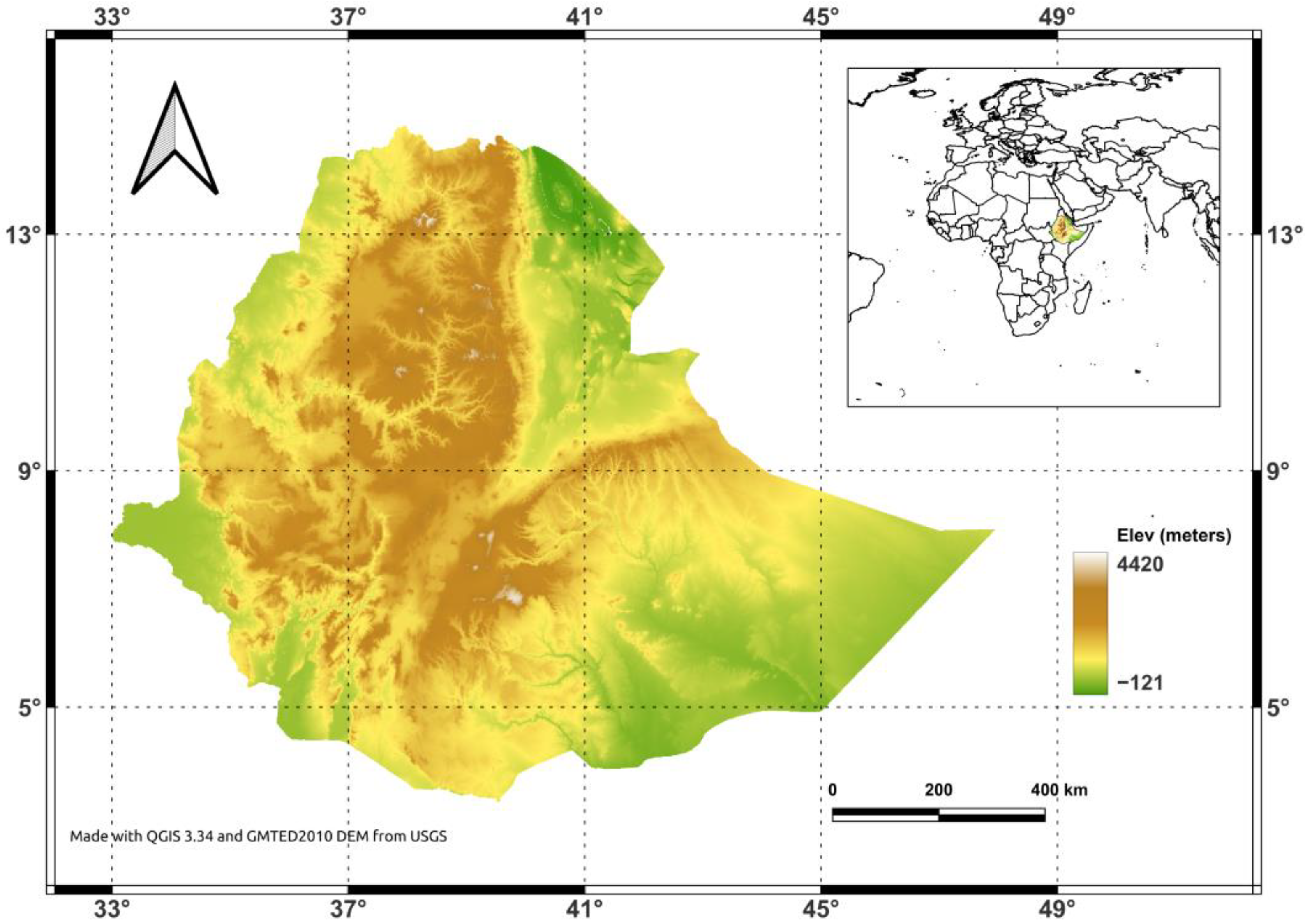

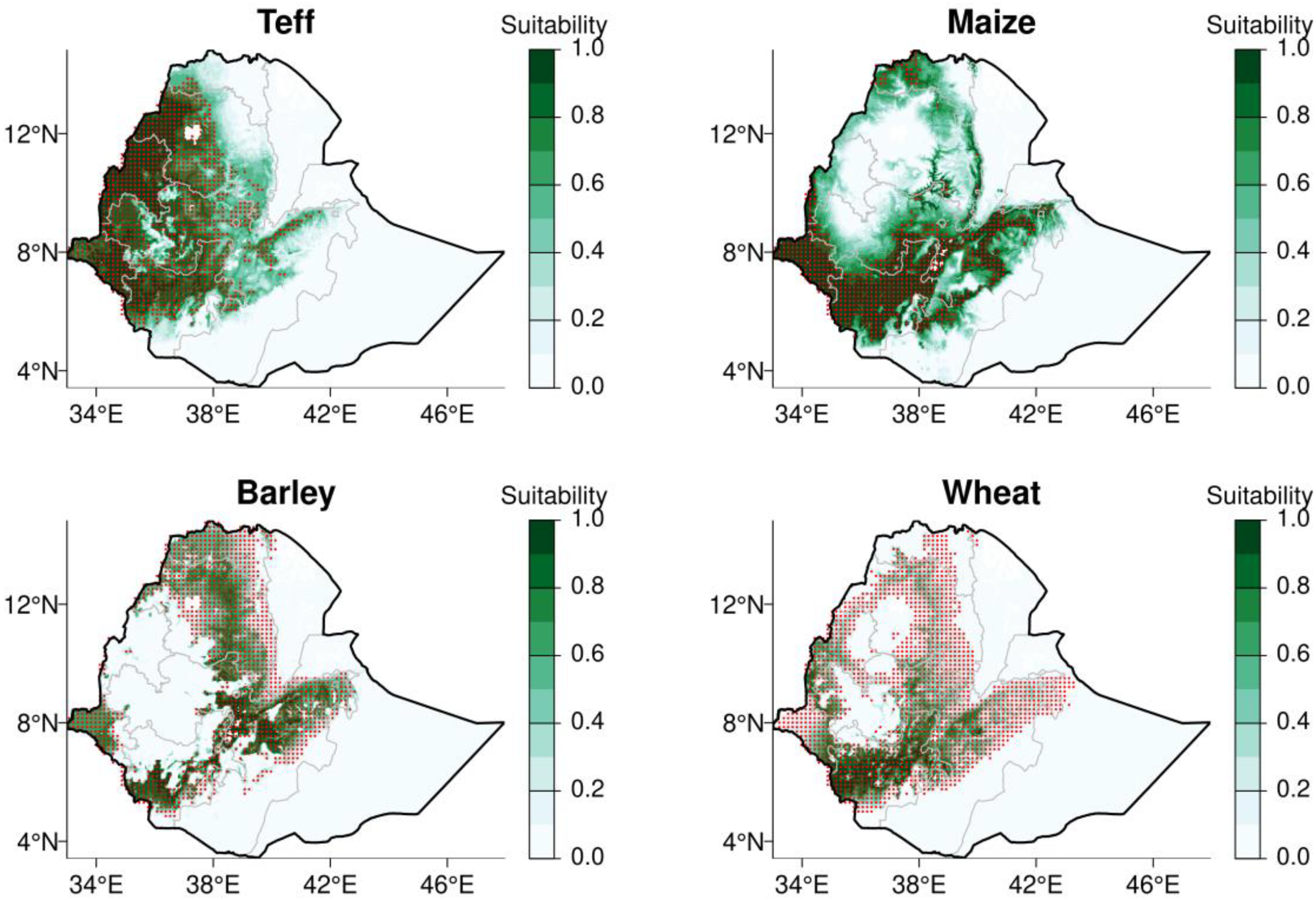
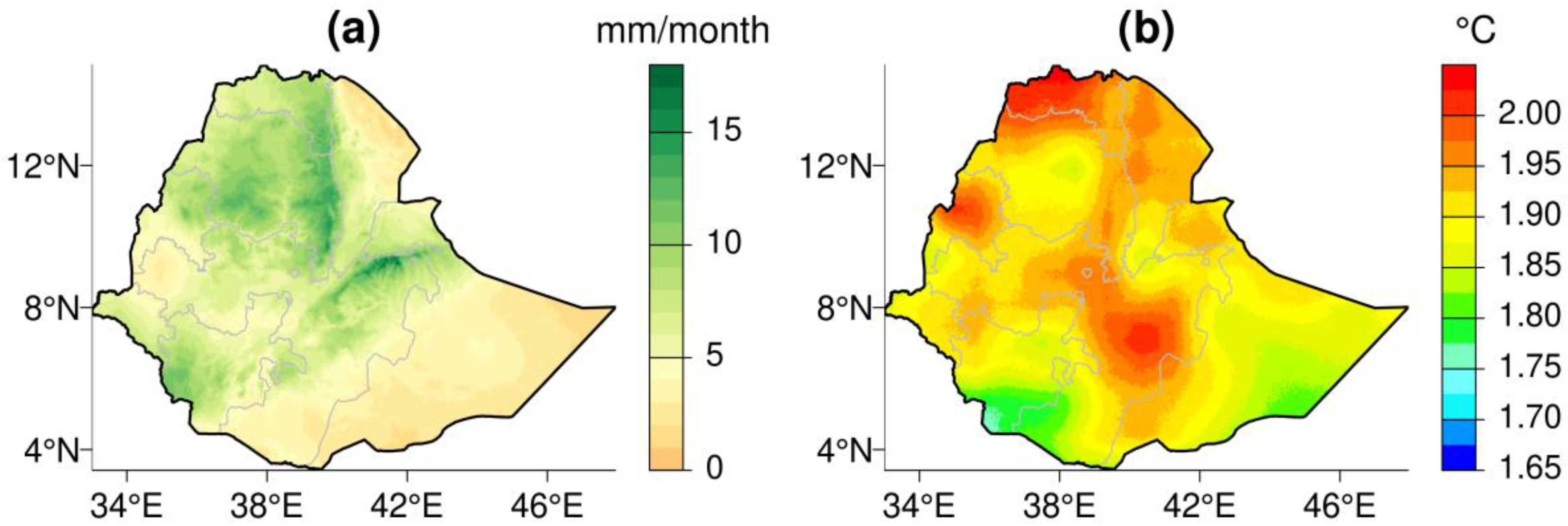
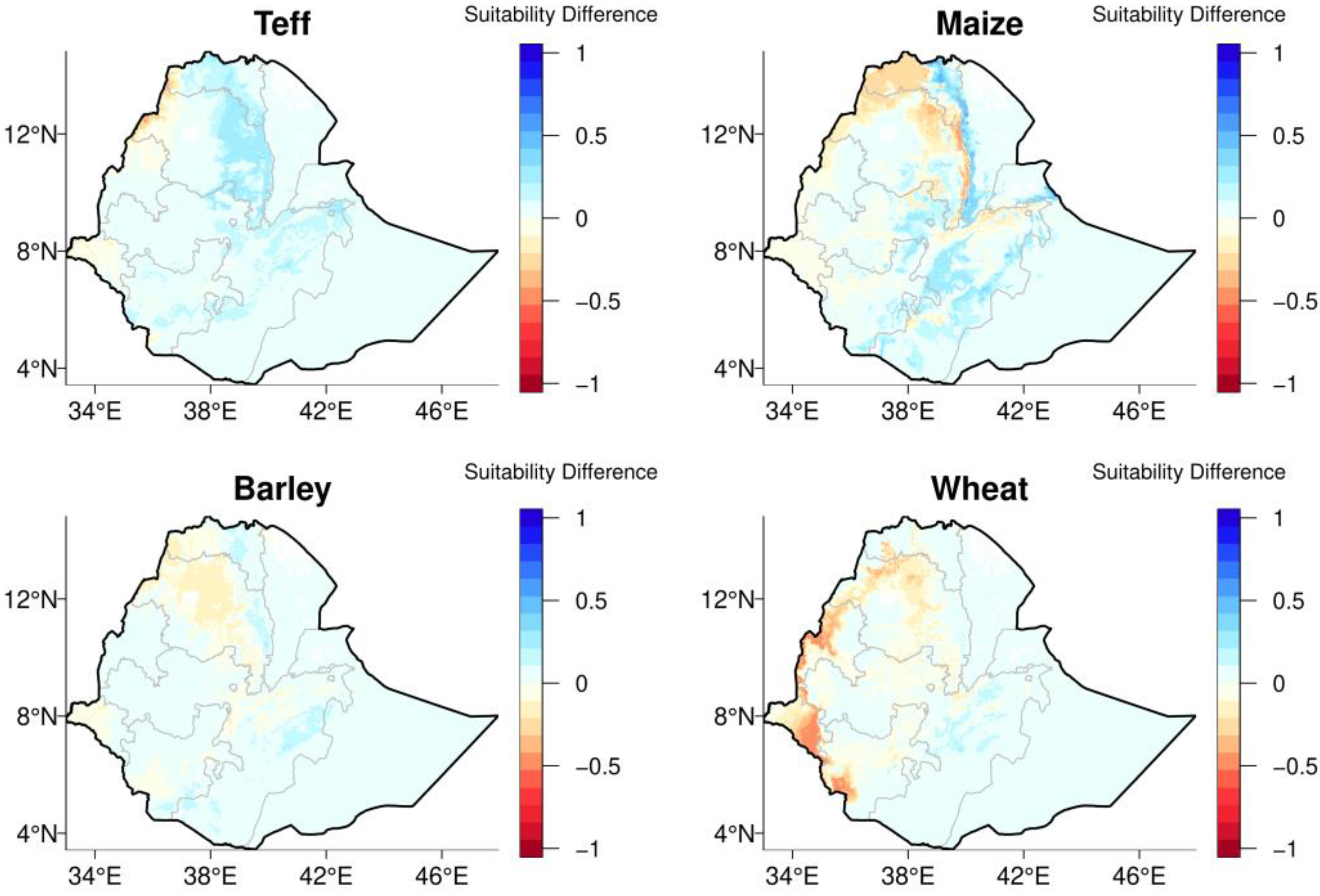
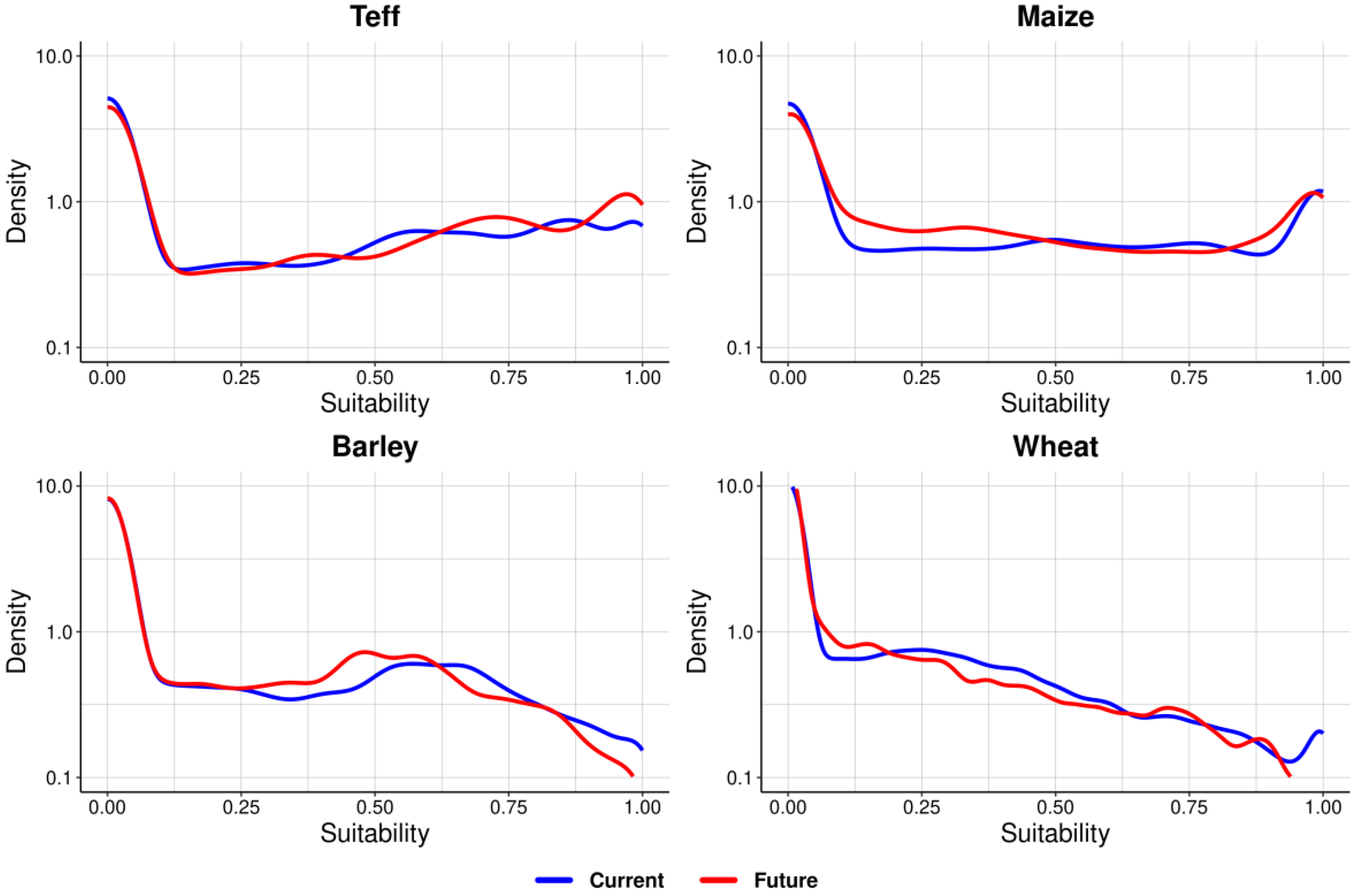
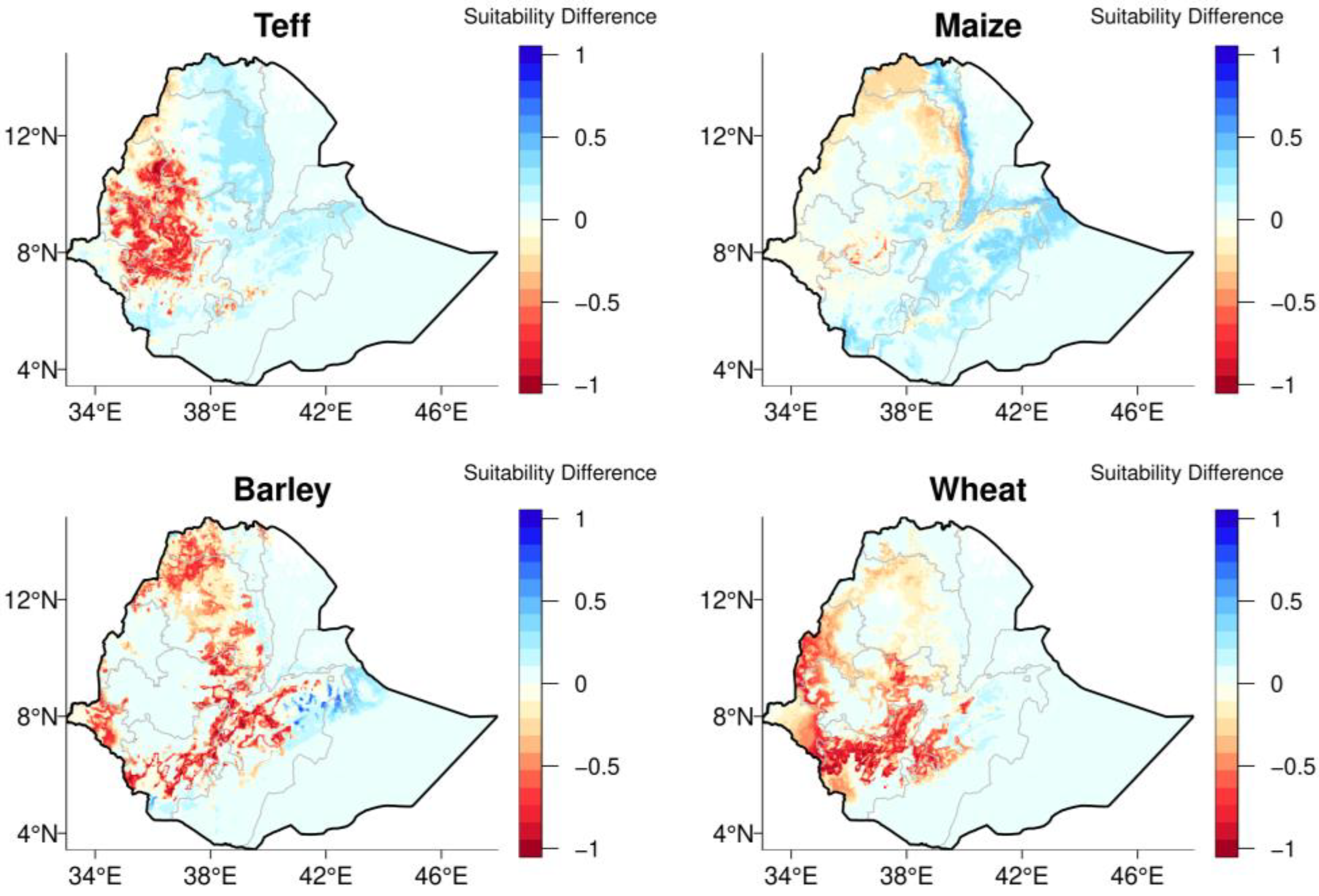
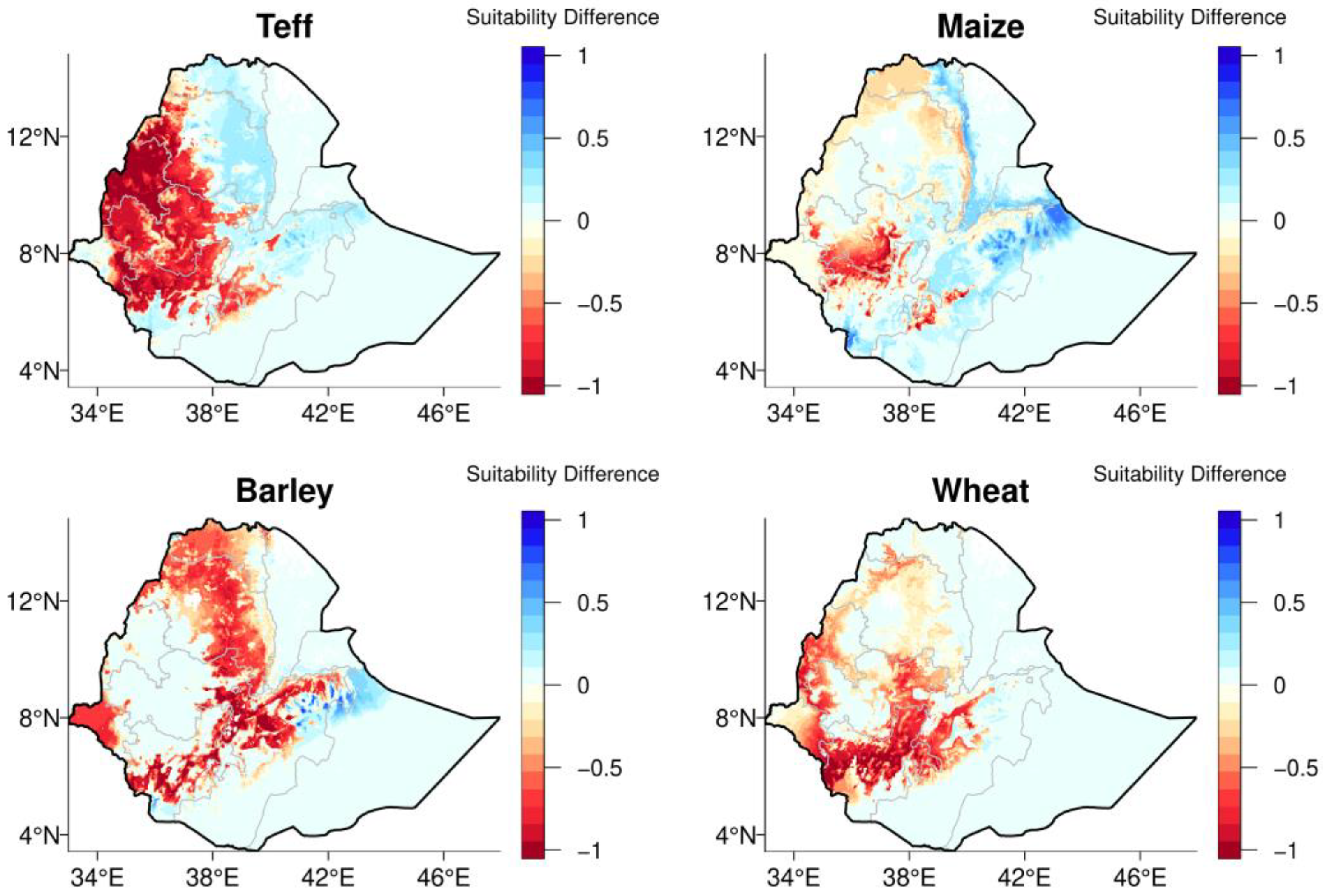
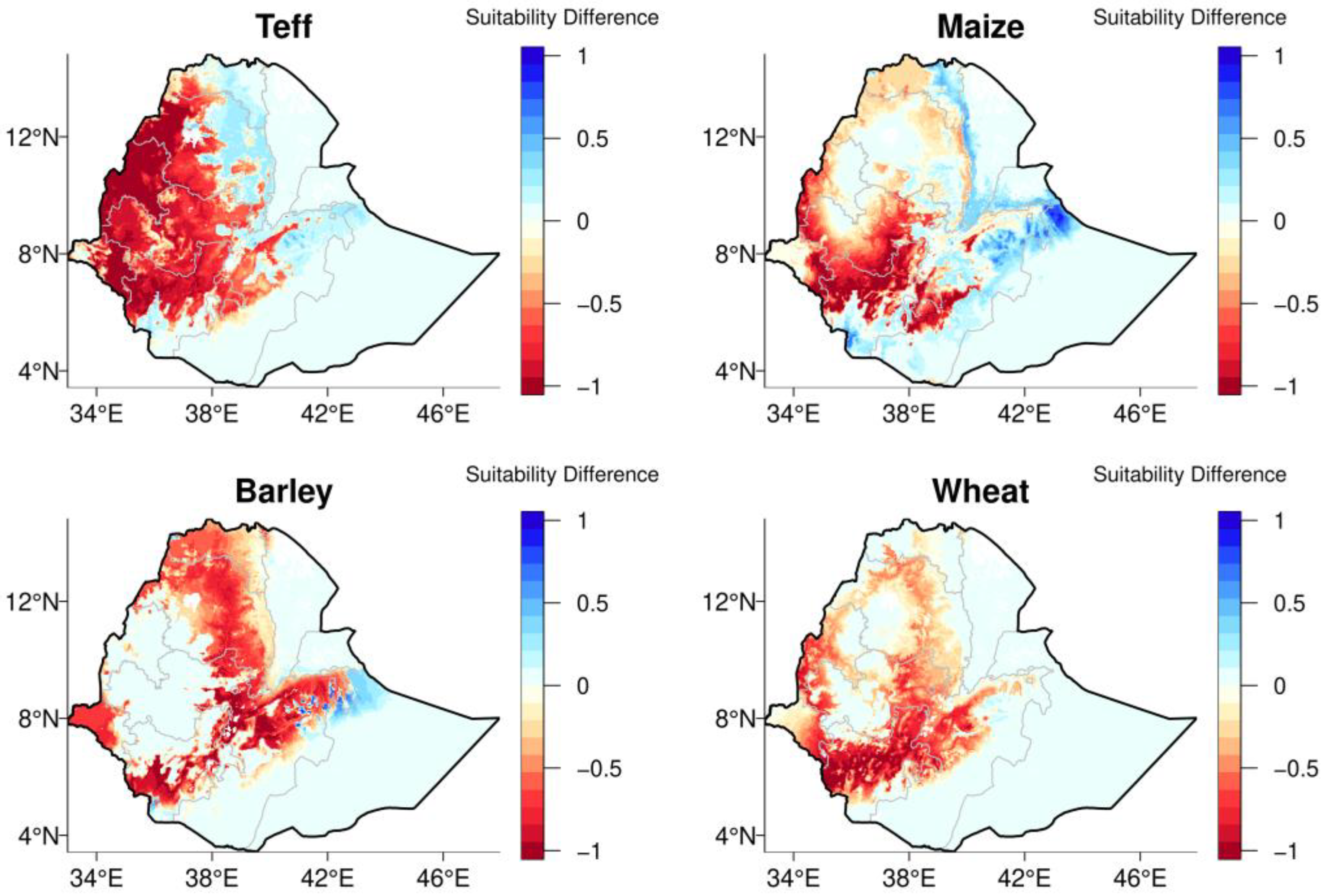
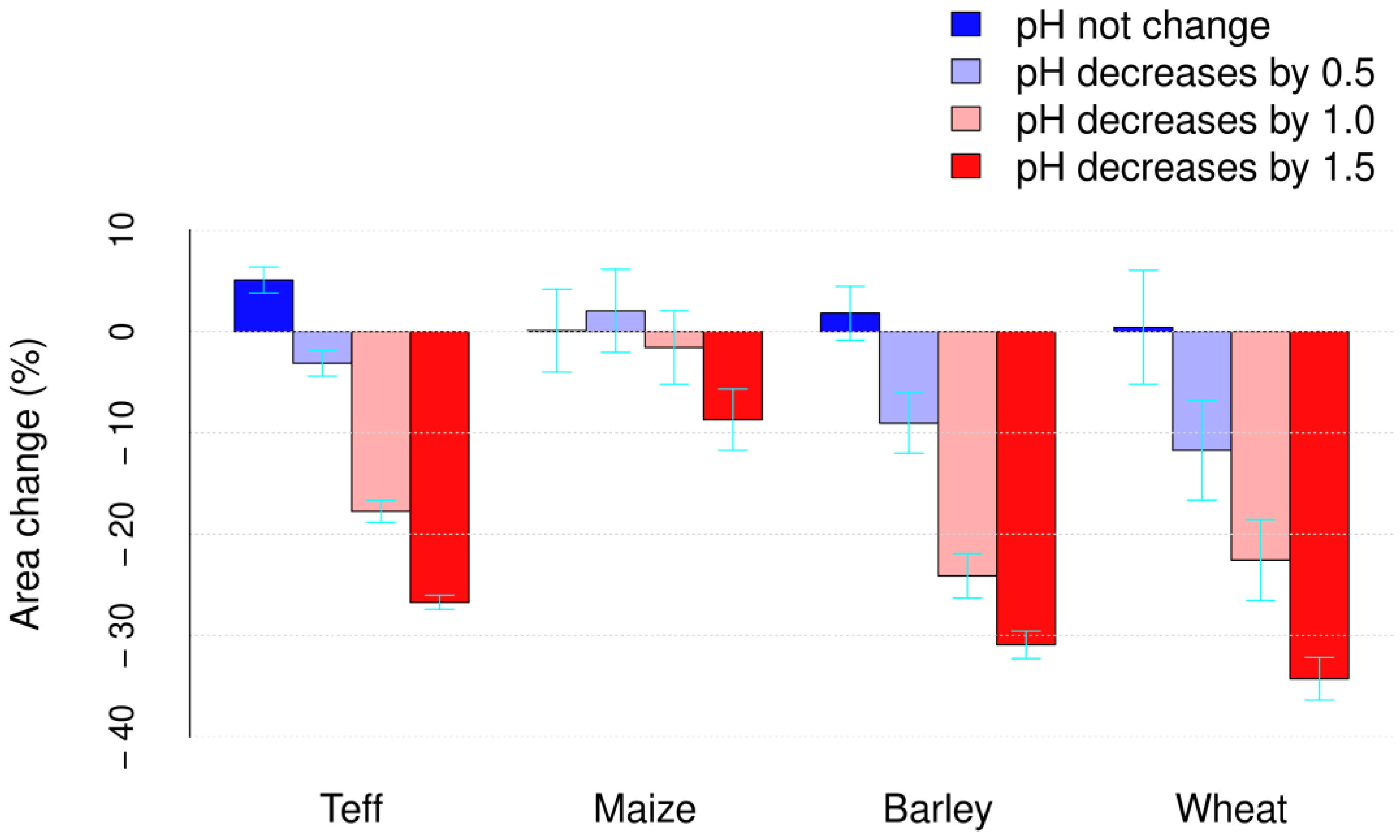
| Climate Models | Model Descriptions | Refs. |
|---|---|---|
| GFDL-ESM4 | Geophysical-Fluid-Dynamics-Laboratory-Earth-System-Model | [43] |
| MPI-ESM1-2-HR | Max Planck Institute for Meteorology, Earth System Model | [44] |
| MRI-ESM2-0 | Meteorological Research Institute (MRI) of Japan, Earth System Model | [45] |
| UKESM1-0-LL | UK Earth System Model | [46] |
| INM-CM5-0 | Institute for Numerical Mathematics, Climate Model | [47] |
| CMCC-ESM2 | Centro Euro-Mediterraneo sui Cambiamenti Climatici, Earth System Model. | [48] |
| IPSL-CM6A-LR | Institut Pierre-Simon Laplace, Climate Model | [49] |
| Crop Name | Scientific Name | Area Harvested (000 ha) [59] | Yield (t/ha) [59] |
|---|---|---|---|
| Teff | Eragrostis tef (Zucc.) Trot | 3017 | 1.71 |
| Maize | Zea mays L. s. mays | 2530 | 4.24 |
| Barley | Hordeum vulgare L. | 960 | 2.45 |
| Wheat | Triticum aestivum L. | 1950 | 2.67 |
| Crops | Precipitation Range (mm/Month) | Temperature Range (°C) | pH Ranges |
|---|---|---|---|
| Teff | 65–389 | 2–28 | 5.0–6.5 |
| Maize | 49–180 | 10–33 | 4.5–7.0 |
| Barley | 31–200 | 2–20 | 6.0–7.5 |
| Wheat | 45–174 | 5–23 | 5.5–7.0 |
Disclaimer/Publisher’s Note: The statements, opinions and data contained in all publications are solely those of the individual author(s) and contributor(s) and not of MDPI and/or the editor(s). MDPI and/or the editor(s) disclaim responsibility for any injury to people or property resulting from any ideas, methods, instructions or products referred to in the content. |
© 2024 by the authors. Licensee MDPI, Basel, Switzerland. This article is an open access article distributed under the terms and conditions of the Creative Commons Attribution (CC BY) license (https://creativecommons.org/licenses/by/4.0/).
Share and Cite
Jimma, T.B.; Chemura, A.; Spillane, C.; Demissie, T.; Abera, W.; Ture, K.; Terefe, T.; Solomon, D.; Gleixner, S. Coupled Impacts of Soil Acidification and Climate Change on Future Crop Suitability in Ethiopia. Sustainability 2024, 16, 1468. https://doi.org/10.3390/su16041468
Jimma TB, Chemura A, Spillane C, Demissie T, Abera W, Ture K, Terefe T, Solomon D, Gleixner S. Coupled Impacts of Soil Acidification and Climate Change on Future Crop Suitability in Ethiopia. Sustainability. 2024; 16(4):1468. https://doi.org/10.3390/su16041468
Chicago/Turabian StyleJimma, Tamirat B., Abel Chemura, Charles Spillane, Teferi Demissie, Wuletawu Abera, Kassahun Ture, Tadesse Terefe, Dawit Solomon, and Stephanie Gleixner. 2024. "Coupled Impacts of Soil Acidification and Climate Change on Future Crop Suitability in Ethiopia" Sustainability 16, no. 4: 1468. https://doi.org/10.3390/su16041468
APA StyleJimma, T. B., Chemura, A., Spillane, C., Demissie, T., Abera, W., Ture, K., Terefe, T., Solomon, D., & Gleixner, S. (2024). Coupled Impacts of Soil Acidification and Climate Change on Future Crop Suitability in Ethiopia. Sustainability, 16(4), 1468. https://doi.org/10.3390/su16041468






